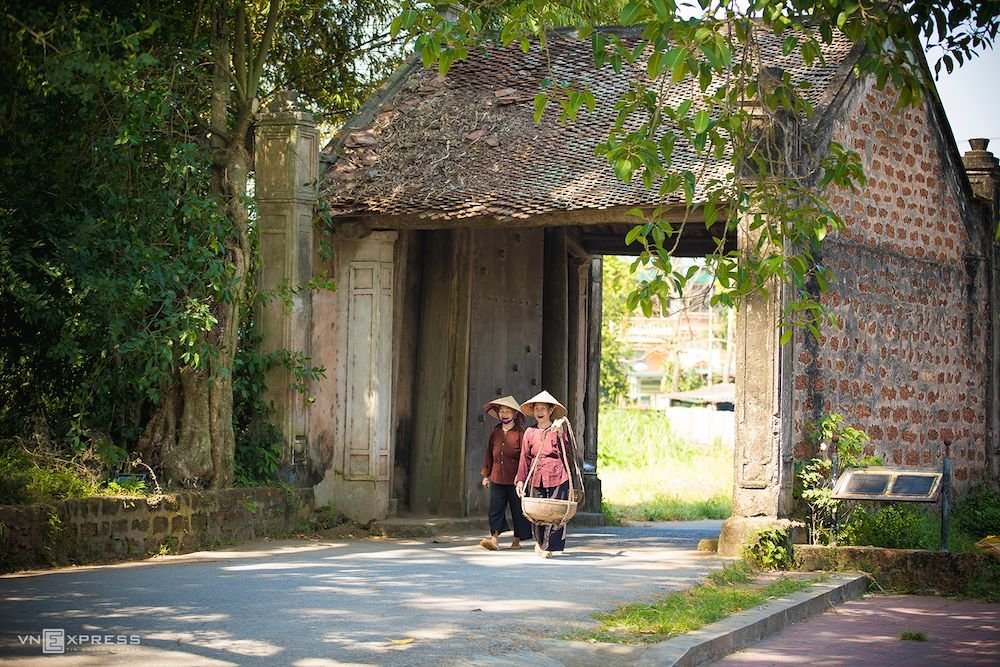If you’re yearning for a quiet escape from the bustle of Hanoi and a chance to step into a slower, simpler era, head just 50 kilometers west to Duong Lam Ancient Village. Often described as a “living museum” of Vietnamese rural life, this centuries-old settlement offers an immersive glimpse into the country’s past — where ancient houses, timeworn traditions, and heartfelt hospitality blend seamlessly.
Duong Lam isn’t merely a destination to check off your list. It’s a journey into Vietnam’s enduring spirit — where every stone wall and wooden beam seems to echo with the stories of generations long gone.
A Journey Through Time and Architecture
Located in Son Tay Town, about 1.5 hours by car or motorbike from central Hanoi, Duong Lam is one of the few Vietnamese villages to retain its original layout, architecture, and cultural practices. Its narrow, winding alleys are flanked by walls built of laterite stone — a reddish, iron-rich rock harvested locally, known for its rustic beauty and incredible durability.
As you walk through the village, you’ll encounter more than 900 traditional houses, many over 300–400 years old. With weathered tiled roofs, dark wooden frames, and open courtyards, these structures reflect ancient Vietnamese architectural principles — simplicity, symmetry, and harmony with nature.
What makes the experience even more profound is the fact that many of these homes are still inhabited by descendants of the original families. Life here follows the gentle rhythm of the seasons: morning markets, shared meals in shaded courtyards, and stories passed down from grandparents to grandchildren.

Cultural Heritage and Historical Significance
Duong Lam holds a special place in Vietnam’s national story. It’s the birthplace of two revered kings — Phung Hung and Ngo Quyen — both celebrated for their leadership in repelling foreign invaders and securing Vietnamese independence in the 8th and 10th centuries, respectively.
Key historical sites to explore:
- Mong Phu Communal House: This is the heart of village life, where ceremonies, festivals, and community gatherings have taken place for centuries. The architecture reflects both elegance and humility — a quintessential example of traditional Vietnamese wooden construction.
- Ngo Quyen Temple and Mausoleum: Set amidst peaceful rice paddies, this complex honors the general-turned-king who defeated the Southern Han army in 938 AD, marking the beginning of Vietnam’s independence from Chinese rule.
- Phung Hung Temple: A serene space dedicated to a local hero who led a major uprising against Tang Dynasty forces. The temple grounds offer quiet beauty and a chance to reflect on Vietnam’s centuries-long struggle for autonomy.
In addition to these landmarks, you’ll find numerous ancestral halls, wells, and village gates — all telling the story of Duong Lam’s deep-rooted cultural identity.
Hospitality and the Spirit of the Village
While the architecture and history are remarkable, it’s the people of Duong Lam who truly bring the village to life. Don’t be surprised if a local elder greets you with a smile and offers a seat in their home for green tea and conversation. Many residents are proud to share their stories and traditions, including cooking, crafts, and oral history.
Some households offer homestays, where visitors can enjoy traditional meals made with locally grown ingredients. Dishes might include:
- Bánh tẻ – a savory rice cake wrapped in banana leaves
- Kẹo lạc – crunchy peanut candy made with malt syrup
- Canh cua đồng – crab soup made with freshwater field crabs
- Steamed rice with sesame salt – a humble, nostalgic dish enjoyed across generations
Staying overnight gives travelers a rare opportunity to live the local life — waking to the sound of birds, walking through misty rice fields, and sharing meals around low wooden tables.
Best Things to Do in Duong Lam Ancient Village
- Stroll Through the Ancient Alleys: Admire ancient architecture, peek into family courtyards, and chat with friendly locals along the way.
- Rent a Bicycle: Cycle through the village and its surrounding countryside, past lotus ponds, banyan trees, and rice paddies.
- Join a Traditional Cooking Class: Learn how to make Duong Lam specialties from a village cook in their own home.
- Explore the Communal Houses: Discover the unique functions and sacred importance of these village gathering spaces.
- Photography: Golden-hour light, crumbling stone walls, ancient doors, and weathered faces make Duong Lam a dream for cultural and street photographers.

How to Get to Duong Lam Ancient Village
Getting to Duong Lam from Hanoi is simple:
- By private car or taxi: The drive takes approximately 1.5 hours and offers comfort and flexibility.
- By motorbike: A scenic and affordable option for independent travelers.
- By public bus: Buses to Son Tay run frequently from Hanoi’s My Dinh Bus Station, followed by a short taxi or xe om (motorbike taxi) ride to the village.
Best Time to Visit
- Spring (February–April): Pleasant weather, blooming flowers, and festival season in full swing.
- Autumn (September–November): Cool temperatures, golden rice fields, and perfect light for photography.
- Weekdays: Visit during the week to avoid weekend crowds and enjoy a more peaceful experience.
Travel Tips
- Wear comfortable shoes – The alleys are charming but uneven.
- Bring a camera – You’ll want to capture the textures, colors, and smiles.
- Learn a few Vietnamese greetings – Locals always appreciate the effort.
- Support local families – Buy handmade crafts, enjoy a home-cooked meal, or stay overnight.
Why Duong Lam Belongs on Every Culture Lover’s Itinerary
In a country racing toward modernization, Duong Lam Ancient Village is a precious reminder of Vietnam’s roots. Here, time slows down. History isn’t confined to museums — it’s lived in the homes, temples, and daily lives of the villagers.
For culture buffs, history enthusiasts, photographers, or anyone yearning to step into the soul of rural Vietnam, Duong Lam offers an unforgettable, deeply human experience. It’s not about sightseeing — it’s about connection, authenticity, and quiet beauty that lingers long after you’ve left.



